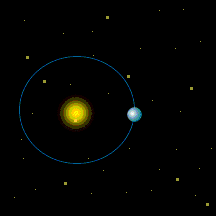I came across this topic and was wondering, exactly where in this 100,000 year cycle are we at this time? And how might this be affecting our current weather?
The most important orbital change studied by Milankovich is the change in the shape of the Earth's orbit from nearly circular to slightly elongate and back again. The time it takes to go through a complete cycle from circular to elongate and back to circular is about 100,000 years.
Please note that the change in orbital shape shown in the animation is much, much, much larger than the actual change in the Earth's orbit. If the animation showed the actual change in shape, you would not be able to detect it with your eye. The effect has been greatly exaggerated so that you can easily see it.
During the portion of the shape change cycle when the orbit is nearly circular, the Earth-Sun distance is nearly the same for all parts of the orbit, making the Earth's average temperature the same all year round. As the orbit becomes more elongate, the Earth orbits slightly farther from the Sun at aphelion and slightly closer at perihelion, making the average temperature slightly lower at aphelion and slightly higher six months later at perihelion. Also, since the Earth moves more slowly near aphelion, when the orbit is elongated, the time during which the temperatures are lower lasts slightly longer.
http://www.cotf.edu/ete/modules/msese/dinosaurflr/shape.html


